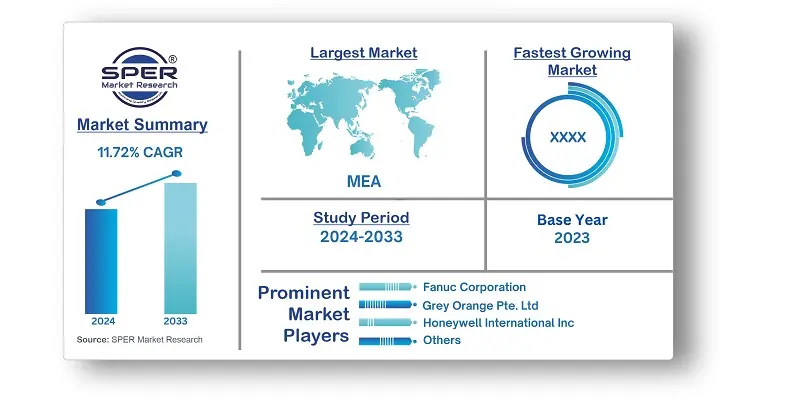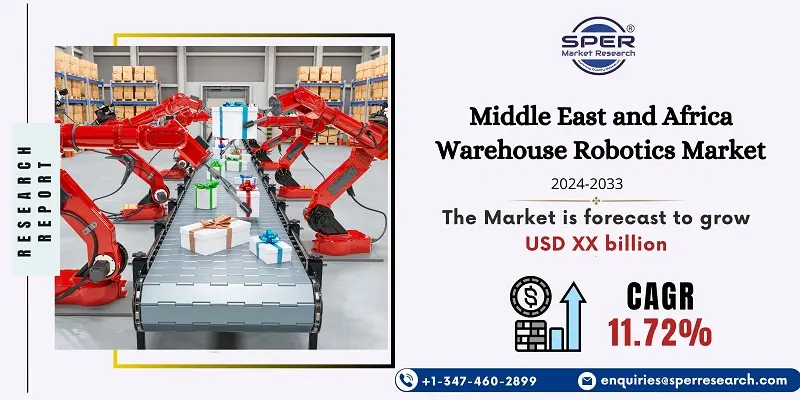
Middle East and Africa Warehouse Robotics Market Growth, Size, Trends, Share and Future Outlook
Middle East and Africa Warehouse Robotics Market Size- By Type, By Function, By End User- Regional Outlook, Competitive Strategies and Segment Forecast to 2033
| Published: Mar-2024 | Report ID: AMIN2472 | Pages: 1 - 156 | Formats*: |
| Category : Automotive & Transportation | |||
- September2020: With the introduction of the IRB 1300, ABB expanded its line of tiny, six-axis industrial robots to satisfy consumer demand for speedier, more portable robots that can handle large, awkwardly shaped loads or things quickly.
- Yaskawa, April 2020: a new range of shelf-type robots that strengthens to save space in facilities, the Motoman-GP300R, a new multipurpose robot, was introduced. It works downwards and has a large footprint mounting area, which makes it perfect for addressing tasks from above.


| Report Metric | Details |
| Market size available for years | 2020-2033 |
| Base year considered | 2023 |
| Forecast period | 2024-2033 |
| Segments covered | By Type, By Function, By End Use |
| Regions covered | Saudi Arabia, Africa, United Arab Emirates, Rest of middle East and Africa |
| Companies Covered | Fanuc Corporation, Grey Orange Pte. Ltd, Honeywell International Inc., Kuka AG, Limited, Singapore Technologies Engineering Ltd, Syrius Robotics, Toshiba Corporation, Yaskawa Electric Corporation, Others. |
- Businesses and Enterprises
- Manufacturers and Suppliers
- Logistics and Supply Chain Professionals
- Investors and Financial Institutions
- Government Agencies and Regulatory Bodies
- Research and Consulting Firms
- Trade Associations and Industry Groups
- Academic Institutions and Educational Centers
- End Users and Decision-Makers
| By Type: |
|
| By Function: |
|
| By End user: |
|
- Middle East and Africa Warehouse Robotics Market Size (FY’2024-FY’2033)
- Overview of Middle East and Africa Warehouse Robotics Market
- Segmentation of Middle East and Africa Warehouse Robotics Market By Type (Industrial Robots, Sortation System, Conveyors, Palletizars, Automated Storage and Retrieval System, Mobile Robots)
- Segmentation of Middle East and Africa Warehouse Robotics Market By Function (Storage, Packaging, Trans Shipments, Others)
- Segmentation of Middle East and Africa Warehouse Robotics Market By End User (Food and Beverage, Automotive, Retail, Electrical and Electronics, Pharmaceutical, Others)
- Expansion Analysis of Middle East and Africa Warehouse Robotics Market
- Problems and Obstacles in Middle East and Africa Warehouse Robotics Market
- Competitive Landscape in the Middle East and Africa Warehouse Robotics Market
- Impact of COVID-19 and Demonetization on Middle East and Africa Warehouse Robotics Market
- Details on Current Investment in Middle East and Africa Warehouse Robotics Market
- Competitive Analysis of Middle East and Africa Warehouse Robotics Market
- Prominent Players in the Middle East and Africa Warehouse Robotics Market
- SWOT Analysis of Middle East and Africa Warehouse Robotics Market
- Middle East and Africa Warehouse Robotics Market Future Outlook and Projections (FY’2024-FY’2033)
- Recommendations from Analyst
1.1. Scope of the report1.2. Market segment analysis
2.1. Research data source2.1.1. Secondary Data2.1.2. Primary Data2.1.3. SPER’s internal database2.1.4. Premium insight from KOL’s2.2. Market size estimation2.2.1. Top-down and Bottom-up approach
2.3. Data triangulation
4.1. Driver, Restraint, Opportunity and Challenges analysis4.1.1. Drivers4.1.2. Restraints4.1.3. Opportunities4.1.4. Challenges4.2. COVID-19 Impacts of the Middle East and Africa Warehouse Robotics Market
5.1. SWOT Analysis5.1.1. Strengths5.1.2. Weaknesses5.1.3. Opportunities5.1.4. Threats5.2. PESTEL Analysis5.2.1. Political Landscape5.2.2. Economic Landscape5.2.3. Social Landscape5.2.4. Technological Landscape5.2.5. Environmental Landscape5.2.6. Legal Landscape5.3. PORTER’s Five Forces5.3.1. Bargaining power of suppliers5.3.2. Bargaining power of buyers5.3.3. Threat of Substitute5.3.4. Threat of new entrant5.3.5. Competitive rivalry5.4. Heat Map Analysis
6.1. Middle East and Africa Warehouse Robotics Market Manufacturing Base Distribution, Sales Area, Product Type6.2. Mergers & Acquisitions, Partnerships, Product Launch, and Collaboration in Middle East and Africa Warehouse Robotics Market
7.1. Middle East and Africa Warehouse Robotics Market Value Share and Forecast, By Type, 2024-20337.2. Industrial Robots7.3. Sortation System7.4. Conveyors7.5. Palletizars7.6. Automated Storage and Retrieval System7.7. Mobile Robots
8.1. Middle East and Africa Warehouse Robotics Market Value Share and Forecast, By Function, 2024-20338.2. Storage8.3. Packaging8.4. Trans Shipments8.5. Others
9.1. Middle East and Africa Warehouse Robotics Market Value Share and Forecast, By End user, 2024-20339.2. Food and Beverage9.3. Automotive9.4. Retail9.5. Electrical and Electronics9.6. Pharmaceutical9.7. Others
10.1. Middle East and Africa Warehouse Robotics Market Size and Market Share
11.1. Middle East and Africa Warehouse Robotics Market Size and Market Share By Type (2020-2026)11.2. Middle East and Africa Warehouse Robotics Market Size and Market Share By Type (2027-2033)
12.1. Middle East and Africa Warehouse Robotics Market Size and Market Share By Function (2020-2026)12.2. Middle East and Africa Warehouse Robotics Market Size and Market Share By Function (2027-2033)
13.1. Middle East and Africa Warehouse Robotics Market Size and Market Share By End user (2020-2026)13.2. Middle East and Africa Warehouse Robotics Market Size and Market Share By End user (2027-2033)
14.1. Middle East and Africa Warehouse Robotics Market Size and Market Share By Region (2020-2026)14.2. Middle East and Africa Warehouse Robotics Market Size and Market Share By Region (2027-2033)14.3. Saudi Arabia14.4. South Africa14.5. United Arab Emirates14.6. Rest of middle East and Africa
15.1. Fanuc Corporation15.1.1. Company details15.1.2. Financial outlook15.1.3. Product summary15.1.4. Recent developments15.2. Grey Orange Pte. Ltd15.2.1. Company details15.2.2. Financial outlook15.2.3. Product summary15.2.4. Recent developments15.3. Honeywell International Inc.15.3.1. Company details15.3.2. Financial outlook15.3.3. Product summary15.3.4. Recent developments15.4. Kuka AG15.4.1. Company details15.4.2. Financial outlook15.4.3. Product summary15.4.4. Recent developments15.5. Limited15.5.1. Company details15.5.2. Financial outlook15.5.3. Product summary15.5.4. Recent developments15.6. Singapore Technologies Engineering Ltd15.6.1. Company details15.6.2. Financial outlook15.6.3. Product summary15.6.4. Recent developments15.7. Syrius Robotics15.7.1. Company details15.7.2. Financial outlook15.7.3. Product summary15.7.4. Recent developments15.8. Toshiba Corporation15.8.1. Company details15.8.2. Financial outlook15.8.3. Product summary15.8.4. Recent developments15.9. Yaskawa Electric Corporation15.9.1. Company details15.9.2. Financial outlook15.9.3. Product summary15.9.4. Recent developments15.10. Others
SPER Market Research’s methodology uses great emphasis on primary research to ensure that the market intelligence insights are up to date, reliable and accurate. Primary interviews are done with players involved in each phase of a supply chain to analyze the market forecasting. The secondary research method is used to help you fully understand how the future markets and the spending patterns look likes.
The report is based on in-depth qualitative and quantitative analysis of the Product Market. The quantitative analysis involves the application of various projection and sampling techniques. The qualitative analysis involves primary interviews, surveys, and vendor briefings. The data gathered as a result of these processes are validated through experts opinion. Our research methodology entails an ideal mixture of primary and secondary initiatives.



Frequently Asked Questions About This Report
PLACE AN ORDER
Year End Discount
Sample Report
Pre-Purchase Inquiry
NEED CUSTOMIZATION?
Request CustomizationCALL OR EMAIL US
100% Secure Payment






Related Reports
Our Global Clients
Our data-driven insights have influenced the strategy of 200+ reputed companies across the globe.




















